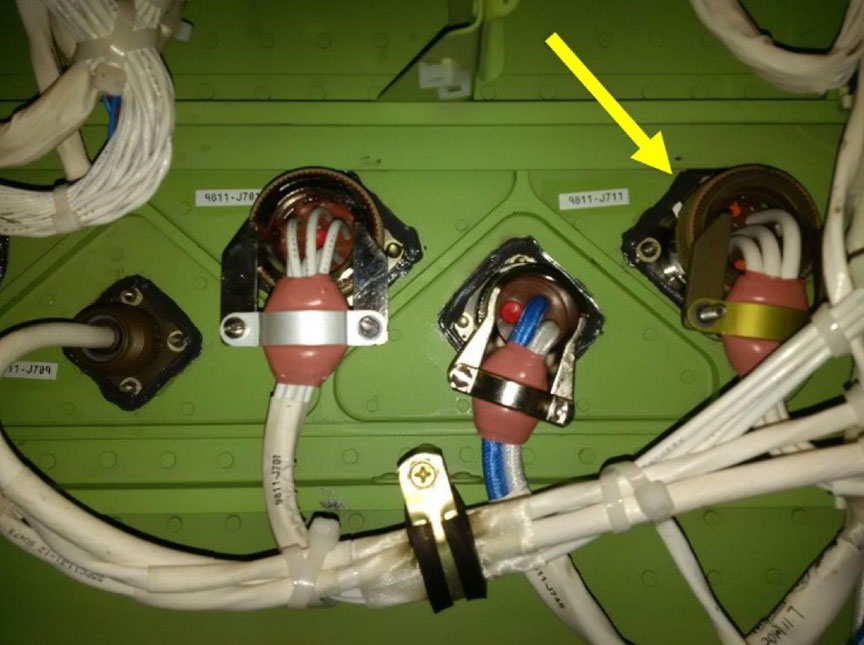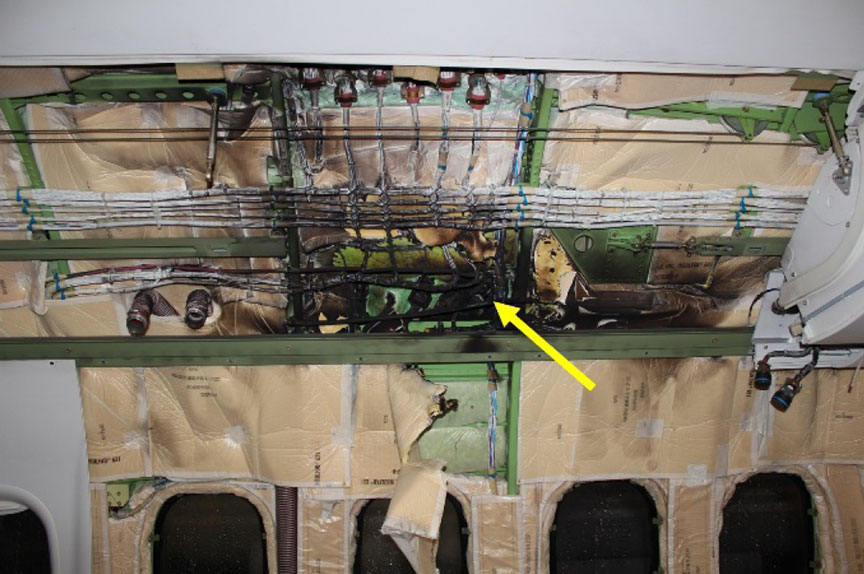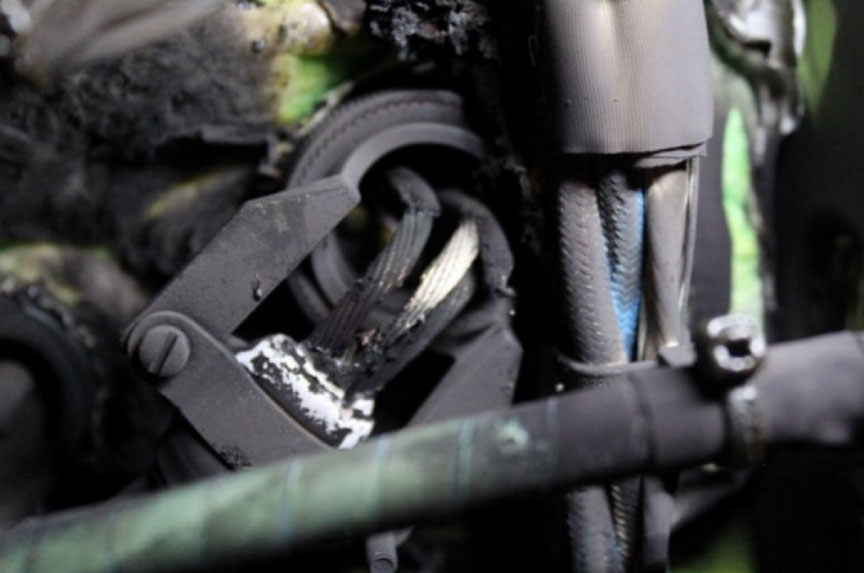In-flight electrical arcing
Porter Airlines Inc.
Bombardier DHC-8-402, C-GLQG
Fredericton, New Brunswick, 45 nm SW
The Transportation Safety Board of Canada (TSB) investigated this occurrence for the purpose of advancing transportation safety. It is not the function of the Board to assign fault or determine civil or criminal liability. This report is not created for use in the context of legal, disciplinary or other proceedings. See Ownership and use of content. Masculine pronouns and position titles may be used to signify all genders to comply with the Canadian Transportation Accident Investigation and Safety Board Act (S.C. 1989, c. 3).
History of the flight
At 0851Footnote 1 on 10 March 2018, the Porter Airlines Inc. (Porter Airlines) Bombardier DHC‑8‑402 aircraft (registration C‑GLQG, serial number 4194), operating as flight 1480 (POE1480), departed Halifax/Stanfield International Airport (CYHZ), Nova Scotia, bound for Montréal/Pierre Elliott Trudeau International Airport (CYUL), Quebec, with 2 flight crew members, 2 cabin crew members, and 72 passengers on board.
At about 0922, while in cruise flight approximately 45 nautical miles (nm) southwest of Fredericton International Airport (CYFC), New Brunswick, passengers alerted the cabin crew to a burning odour and sparks emanating from behind the overhead bin near the cabin wall above seat 14A, on the left side of the cabin. The cabin crew alerted the flight crew to the condition and further inspected the area. The odour began to dissipate and no further sparking was observed.
The flight crew carried out the memory items of the “fuselage fire or smoke” emergency checklist and donned their oxygen masks, then declared an emergency and initiated a diversion to CYFC. Caution lights illuminated relating to the loss of No. 1 alternating current (AC) electrical power (PITOT HEAT 1, ENGINE ADAPT HEAT 1, LEFT TRU, and PUSHER SYSTEM FAIL), and other caution lights flickered momentarily.
Once on approach to CYFC, the aircraft travelled through an area of icing, after which caution messages were received indicating that there was an indicated airspeed mismatch,Footnote 2 and that the yaw dampener and autopilot had been disconnected. These messages are consistent with a blocked pitot tube and require that the flight crew manually fly the aircraft and identify which airspeed indication was accurate (the one on the left or the one on the right). In this occurrence, the flight crew were able to determine that the left airspeed indication was incorrect. The inaccuracy was later determined to likely have been caused by the left pitot tube becoming partially blocked by ice formation due to the loss of AC current to the pitot heating element.
The aircraft landed on Runway 09 at CYFC at 0951 without further incident and came to a stop on the runway with airport rescue and firefighting personnel standing by. The cabin crew informed passengers that they would exit the aircraft through the normal cabin door and told them that they should take only jackets and phones; all baggage and other belongings were to be left behind. The flight crew shut down the aircraft and initiated a rapid deplanement.Footnote 3 Passengers quickly exited the aircraft onto the runway as instructed and no injuries were reported. The passengers were then transported to the terminal by bus.
Aircraft information
The DHC-8-402 is a twin-engine turboprop airliner in the Bombardier Q400 series of aircraft.Footnote 4 The occurrence aircraft was configured for 74 passengers.
The aircraft electrical power generation and distribution system supplies electrical energy to all electrical equipment through an AC system and a direct current (DC) generation system.
There are 2 AC generators: the No. 1 AC generator is driven by the left engine and the No. 2 AC generator is driven by the right engine. These generators provide 115 V AC 3‑phase electrical power to AC systems, such as de-icing heaters. They also energize the transformer-rectifier units (TRUs), which are part of the DC generation system.
The AC power feeder distribution system uses 8‑gauge wiring and sends power through AC control boxes, 1 located in each engine nacelle, and feeds their respective No. 1 and No. 2 AC systems. Each phase wire of this power feed is protected by a 50 A thermal-type circuit breaker.
The No. 1 AC power feed wiring is routed through the left wing to enter the fuselage via the aft wing-root connector (designator number 9811-J711) and then forward to the 115 V AC variable-frequency circuit breaker panel in the flight compartment.
The 9811-J711 connector (part number MS3450L24-11S) is a bulkhead‑mount–type electrical connector with a threaded coupling nut. The wires of the 9811-J711 connector are crimped into connector pins that are retained in the connector insulation insert using pin-locking mechanisms, and are secured in position by a strain relief clamp on its 90° backshell (Figure 1). The current carrying capacity of each of the 8-gauge sockets in connector 9811-J711 is rated at 46 A.
Electrical circuit protection
A thermal-type circuit breaker contains a circuit consisting of a bimetallic element and 2 electrical contacts, 1 of which is spring-loaded. When an overcurrent condition occurs, the circuit heats as a function of current flow and time. When the heat exceeds a preset amount, the bimetallic element bends, causing the spring-loaded contact to trip and open the circuit.
Arcing occurs when an electrical conductor, such as a wire, makes an intermittent circuit through conductor-to-conductor contact (short circuit) or conductor-to-frame contact (ground fault or short circuit to ground). Arcing can generate extremely high temperatures at the location of the intermittent contact; however, this intermittent current draw may not be sufficient to heat a thermal-type circuit breaker rapidly, and may delay tripping the circuit breaker.
Damage information
The 50 A thermal-type circuit breaker in the left engine nacelle AC control box was found to have tripped. The source of the smoke and heat damage was determined to be arcing from the 9811-J711 electrical connector plug assembly in the fuselage at the left-wing-root area. The arcing damage of the electrical connector is consistent with an electrical short circuit within the connector. Because of the destructive nature of this arcing, the connector pin–locking mechanisms and insulation insert material were obliterated, and the source of the electrical short could not be identified.
The electrical arcing that occurred before the 50 A thermal‑type circuit breaker tripped caused minor pitting damage to adjacent wiring bundles, and heat damage and sooting to the insulation blankets and the structure of the outer panel of the overhead baggage compartment (Figure 2 and Figure 3).
The TSB Engineering Laboratory performed a computerized tomography (CT) scan of the occurrence electrical connector, then generated 3-dimensional models of the connector superimposed on wiring to represent the manufacturer-specified minimum and the maximum wiring bend radius between the pin-locking mechanisms and the strain relief clamp. The 3-dimensional models were compared to occurrence images, and it was determined that the wiring alignment was correct and that the actual bend radius of the wiring was within manufacturer specifications.
Occurrences in 2016
In 2016, 2 occurrences associated with AC power feeder connectors were documented by the TSB.Footnote 5
In both events, the connectors were found to be heat-damaged. In 1 of the occurrences, the damaged connector was located in an engine nacelle AC control box, and in the other occurrence, connector 9811‑J711 was damaged. Bombardier conducted its own investigation into these 2 occurrences and determined the following:
Footnote 6Other occurrences
Including the 2 occurrences in 2016, Bombardier has been informed of 10 occurrences in which AC power feeder connectors sustained heat damage. Seven were events in which electrical arcing took place, and 4 of those occurred in the cabin at the wing-root area, causing smoke, odour, and the release of a significant amount of soot.
Service Letter DH8-400-SL-24-016
In October 2016, Bombardier issued Service Letter DH8‑400‑SL‑24‑016 to inform Q400 operators of the 2 occurrences associated with AC power feeder connectors that had occurred earlier that year. The service letter explains that incorrectly assembled connectors may result in stress on the connector pin-locking mechanism and that, over time, vibration acting on the locking mechanism may cause fractures and result in an electrical short. It also notes that in 1 case, wires were incorrectly aligned between the strain relief clamp and the wire termination. The service letter advises operators to carry out inspections of specific AC power feeder connectors, including connector 9811-J711, at the next maintenance opportunity. The inspections are intended to detect play in the pin-locking mechanism and to correct conditions where wires became stressed in the assembly process, such as the application of incorrect bend radius or incorrect wiring alignment. The service letter provides specific examples of these conditions, and offers solutions to correct the conditions.
According to Transport Canada, the performance of actions published in service letters (or similar technical publications) by manufacturers is optional unless the actions are made mandatory by an airworthiness directive.Footnote 7 Footnote 8
Response to Service Letter DH8-400-SL-24-016
Air operators are not required to provide confirmation to Bombardier that the inspection and corrective actions specified in the service letter have been completed; therefore, it is not known how many air operators with Q400 series aircraft in their fleet have carried out those actions, or what conditions were identified.
However, 1 air operator did provide Bombardier with details of its findings related to the inspection conducted in accordance with Service Letter DH8‑400‑SL‑24‑016, and recorded multiple connectors that had unsatisfactory conditions including stressed wires, unlocked pin-locking mechanisms, burned connector pins, and damaged insulation material.
Porter Airlines follows a formal company process to review and assess technical information, including all service bulletins and airworthiness directives issued with respect to the company's aircraft and associated aeronautical products. General publications, such as service letters, are not formally assessed but are typically discussed at various working groups and committees attended by Bombardier and other Q400 operators.
After Porter Airlines discussed Service Letter DH8-400-SL-24-016 with Bombardier, the service letter was assessed as low risk and no formal action was taken.
Key safety messages
The incorrect assembly of some AC power feeder connectors has caused stressed wire terminations, a known issue in the Q400 series aircraft fleet. The stressed wire terminations have resulted in heat damage and, in some cases, significant electrical arcing.
The current carrying capacity of connector 9811-J711 is 46 A. However, because the 50 A circuit breaker protecting the circuit is rated at a value exceeding the connector's rating and is of the thermal type, an overcurrent condition could be experienced for a substantial amount of time before the breaker finally trips.
In this occurrence, the cause of the electrical short circuit was not identified. Although electrical arcing damage consistent with previous occurrences was found, the wiring alignment was correct and the bend radius of the wiring was within manufacturer specifications, suggesting that these conditions alone may not be the sole source of the electrical faults and heat damage in the AC power feeder connectors.
Service Letter DH8-400-SL-24-016 advises air operators to carry out inspections to detect play in the pin-locking mechanism and identify conditions that may cause stress in the wires of the AC power feeder connectors. However, the actions published in the service letter have not been made mandatory by an airworthiness directive; it is not known how many air operators have completed the recommended actions specified in the service letter or what conditions have been identified. As a result, the manufacturer may not have the information required to take further action to address this issue.
Safety action taken
Following this occurrence, Porter Airlines began a campaign to carry out the inspections and repairs specified in Service Letter DH8‑400‑SL‑24‑016 at a rate of 2 aircraft per month until the entire fleet has been completed.
This report concludes the Transportation Safety Board's investigation into this occurrence. The Board authorized the release of this report on . It was officially released on .


